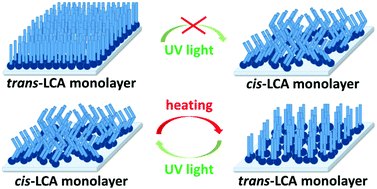Photo-switching of a non-ionic azobenzene amphiphile in Langmuir and Langmuir–Blodgett films†
Abstract
The concept of programmable and reconfigurable soft matter has emerged in science in the last few decades and can be realized by photoisomerization of azobenzene derivatives. This possibility results in great application potential of these compounds in optical storage devices, molecular junctions of electronic devices, command layers of liquid crystal displays or holographic gratings. In this paper, we present the results of a study on the organization and isomerization of the non-ionic and amphiphilic methyl 4-[(E)-2-[4-(nonyloxy)phenyl]diazen-1-yl]benzoate (LCA) in a 2D layer architecture of Langmuir and Langmuir–Blodgett (LB) films supported by spectroscopic studies on LCA chloroform solutions. Our investigation has shown a significantly different molecular organization of LCA depending on the ratio of trans and cis isomers in the monolayers. Taking advantage of a relatively low packing density and aggregation strength in the cis-LCA monolayer, we demonstrated the reversible isomerization in the LB film initially formed of LCA molecules in the cis form, while in the trans-LCA monolayer this effect was not observed. Our approach allows the formation of a switchable monolayer made of the amphiphilic LCA showing liquid crystalline properties without introducing an ionic group into the molecule structure, mixing with another compound or changing the subphase pH to provide free space for the molecules’ isomerization.



 Please wait while we load your content...
Please wait while we load your content...